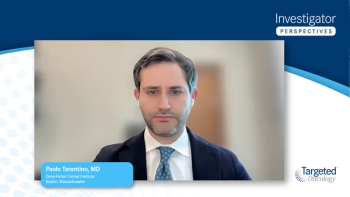
Frontline Treatment Options in AML
A hematologist details the frontline treatment options and goals in acute myeloid leukemia and describes venetoclax.
Daniel Pollyea, MD, MS: At diagnosis, the goals need to be very thoroughly considered. Because for some patients, the goal might be cure. We hope to find that solution for the majority of patients. But that’s not always in the cards because of age or comorbidities at diagnosis. In some cases, the goal is remission and to keep that remission going for as long as possible. If a patient is a transplant candidate, or even a potential transplant candidate, then that’s often the goal that’s moved toward. Because in many cases, except for some select patients with favorable-risk disease, they can be cured only with the transplant. Depending on age and comorbidities, that could be the goal.
What are the different treatment options to address these different goals? The first goal of treatment beyond thinking many moves ahead—how long is the patient going to live and whether you can cure them—is just getting the disease into a remission. At the moment, for younger, fit patients, the recommendation in most cases is to use intensive induction chemotherapy, the so-called 7+3 regimen, to achieve this goal. However, patients with AML [acute myeloid leukemia] have a median age of 68 at diagnosis, and anyone over 60 can have considerable toxicity, morbidity, and mortality with an induction chemotherapy regimen. We now have a variety of other regimens for patients who aren’t candidates for induction chemotherapy at diagnosis. Those would include the venetoclax-based regimens, venetoclax plus an HMA [hypomethylating agent], venetoclax plus low-dose cytarabine, or the Hedgehog inhibitor glasdegib plus low-dose cytarabine. Or if a patient has an IDH1 mutation in the United States, they could be a candidate for ivosidenib as a single-agent therapy, the IDH1 inhibitor.
Once any strategy is successfully used to get a patient into a remission, whether that’s intensive chemotherapy or any of the less intensive options that I just described, a patient could be considered for a transplant if appropriate or treated with consolidation or a maintenance strategy, hopefully for as long as possible until the disease might return. In a nutshell, that’s the way to think about this. This is the way the NCCN [National Comprehensive Cancer Network] has broken down the thought process for the initial approach to this disease.
The monitoring of a patient with AML varies based on the treatment they’ve had. For instance, in a patient who’s had intensive induction chemotherapy and then gets consolidation chemotherapy, there’s usually some end of consolidation bone marrow biopsy to ensure the patient is still in a remission. Then they’re monitored, usually at 3-month intervals for about a 5-year period until they’re released and told that the thinking is they’re cured. For people who are getting less intensive regimens like venetoclax-based regimens, there’s no end date to those, so the patients typically continue those treatments indefinitely. There are different ways to monitor this. Some people will do a bone marrow biopsy every 6 or 12 months. Some people won’t recommend a bone marrow biopsy unless the blood counts reflect some concern about disease recurrence. I don’t think there’s any right or wrong there to the monitoring of those patients. It’s not well known.
With respect to MRD [minimal residual disease], any patient who’s in a remission should be monitored for residual disease. There are many ways to do this. The most popular is with sophisticated flow cytometry–based assays to tell if there’s evidence of residual disease below the surface despite pathologists saying the patient is in a remission, which means no increased blasts in the bone marrow biopsy under a microscope and good count recovery. It’s tough to utilize this evidence in practice. We know that the presence of MRD predicts relapse, worse survival, and is a cause of concern, but we don’t know how to impact this and whether employing a treatment in the setting of MRD can eradicate MRD and improve outcomes. There’s a lot more to be done here. It’s important to monitor for this so that you can set expectations with your patients, but I don’t think we’re at the point where we would make recommendations based on interventions based on the presence or absence of MRD.
BCL2 is a very important protein in the everyday existence of almost every cell in the body. As we all learned as undergraduates, in medical school, and in professional school, cells have to make decisions as to whether they should survive on a minute-by-minute basis based on the environment, what type of cell they are, what they’re doing, etc. It’s a very complicated dance that they’re always doing to decide, “Should we survive or should we die?”
One way that cells normally die is apoptosis. There are proteins responsible for keeping a cell alive and other proteins that are responsible for triggering apoptosis. These 2 sets of proteins are always in some degree of equilibrium. There are pro-apoptotic proteins that promote the destruction or death of a cell, and there are antiapoptotic proteins that do the opposite. BCL2 is 1 of the main antiapoptotic proteins, so its job is to prevent cell death. In cancer cells, the thinking is that this signal is inappropriately overexpressed and that BCL2 is helping cells survive when they should be dying. Cancer cells have a lot of abnormalities, mutations, and lesions. In a normal system, those would trigger cell death, but the overexpression of BCL2 is keeping that from occurring naturally. The thinking is that if you can target BCL2, then you can allow a cancer cell to appropriately die.
The other intriguing part of the mechanism of BCL2 is that for over 10 years, it has been recognized that it appears to be important in the survival of the leukemia stem cell population, the root cause of the disease. In fact, with the venetoclax-azacitidine regimen, that has been shown to specifically target and eradicate the leukemia stem cell population through a novel mechanism that doesn’t have anything to do with what I described to you before about the canonical function of BCL2 and its role in apoptosis. Nevertheless, it seems to be really intriguing. We think it may be responsible for the deep and durable remissions that we see with venetoclax-based regimens.
Transcript edited for clarity.






































